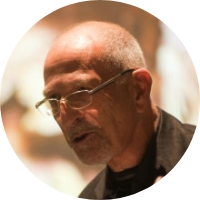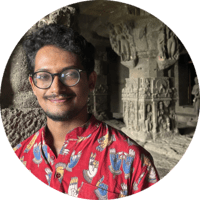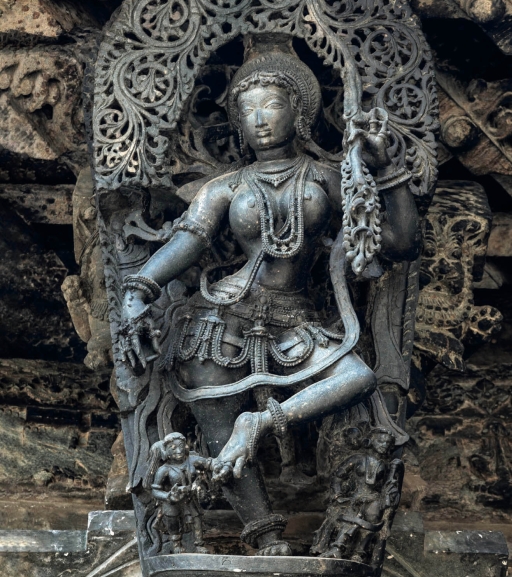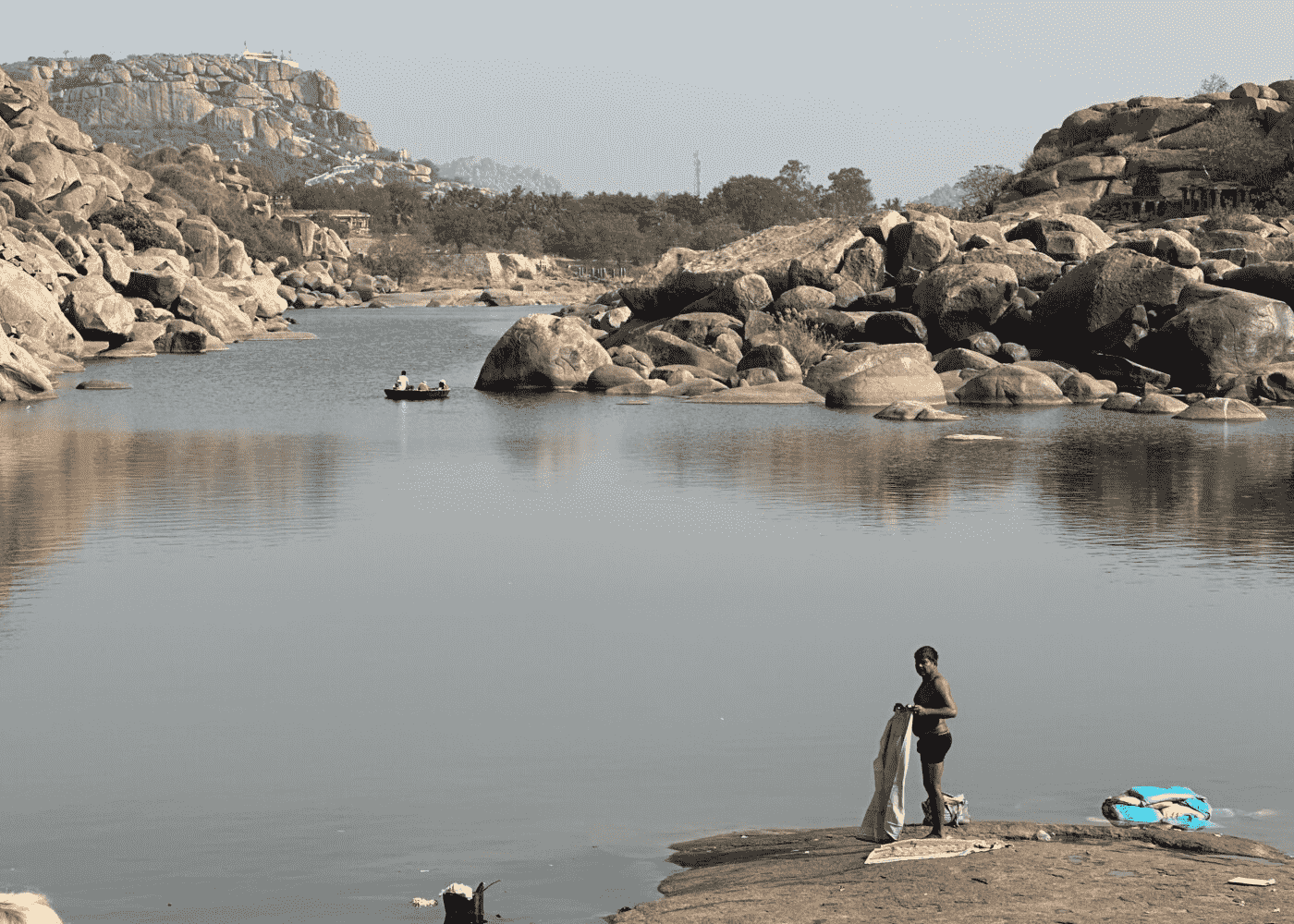Explore the Medieval Metropolis of Vijayanagara with Dr. George Michell
A Conversation with Anirudh Kanisetti
Dr. George Michell and historian Anirudh Kanisetti discuss the unique topography, river hydrology, and religious associations which made Hampi Vijayanagara an important medieval metropolis and shaped the sacred geography of the city. This conversation took place while flowing down the Tungabhadra river in a traditional coracle during a tour of the Deccan sponsored by the Deccan Heritage Foundation.
Programme
January 2024
Introduction
Anirudh Kanisetti We are here on this lovely January morning with the Deccan Heritage Foundation on the river Tungabhadra listening to a ritual that might be as old as the city that we’re all exploring, the medieval metropolis of Vijayanagara. I’m Anirudh Kanisetti and this is Dr. George Michell.
Let’s talk a little about what the city may have looked like as we’re flowing down the Tungabhadra. We must remember that this channel of the river was shaped by extraordinary generations of medieval engineers, and the entire urban layout that we see –- these mandapa, these temples – were all planned to be part of one enormous sacred and secular urban program.
So, George, as we’re flowing down the river, what would the riverbank have looked like all the way from the Virupaksha to the Vitthala temple further down the river?
The River Banks in Vijayanagara Times
George Michell Well, probably the river and the rocks next to the river would have changed because in those days, during the monsoon, the river would have risen a lot higher. There was no dam to control it. And we have carvings on the edges of the river, which probably were submerged during the rainy season. And then beyond that, all these empty, rocky surfaces that you see would probably have been filled with habitations made of materials that have not lasted. So, the emptiness of the landscape is slightly deceptive. We have indications that there were houses; animals were kept, food was prepared, but we just have isolated structures, in between which we don’t see anything anymore. We look up onto these hills, but I think it would have had a sort of crowded urban feeling of which we just see the skeleton today.
Anirudh Kanisetti So, are we talking about fishermen, washer folk, merchants, traders, priests? I also notice as we’re going down the river, all these Shiva carved lingas or the base of what would have been Shiva lingas. And when you mentioned the river’s level would rise, I imagine that the lingas were deliberately positioned so that the river would wash them like the monsoon.
George Michell Absolutely. They were bathed by the sacred river Tungabhadra. We have one wonderful carving of Vishnu reclining on the cosmic serpent on one of these boulders; he also probably would have been submerged or “watered’. And soon we’re coming to a temple with a wonderful Nandy behind us, and that was above the level of the river. But we have old photographs showing the river at a very high level, and I think it does happen very occasionally nowadays in flooding times that the river floods the village of Hampi.
The Sacred Inner Quarters of the Vijayanagara Metropolis
Anirudh Kanisetti So, beyond this urban riverine area, there are also multiple urban cores, if you will, or suburban regions within Vijayanagara itself. Tell us a little bit about them, and how they relate to the temples and the colonnaded streets that dominate our imagination of Vijayanagara today.
George Michell These puras, these sort of urban quarters in this part of the site, were focused on temples: Vitthalapura, Hampi with its Virupaksha pura, Achyutapura, and Krishnapura.
George Michell Each of these had a core shrine with a great temple complex, a great colonnaded street for ceremonies, and an apparatus of secondary structures, mandapas where people could rest, Brahmins could visit, merchants could stay. The puras were in themselves complete, with tanks and water reservoirs, so that each of these was like a mini suburban center – more like an inner core sacred center. And these multiple centers, each focused on a different deity, are particular to Vijayanagara.
Anirudh Kanisetti The very idea of this long colonnaded street versus the concentric padas that you see in deeper South India, seems to be a Vijayanagara invention.
Temples Built on a East-West Axis, with a 15 Degree Deviation
George Michell I don’t think we have any evidence of it in earlier temple architecture. It’s a specialty of this area and has to do with chariots being paraded up and down a street. And the curious thing is that at least three of them are on a particular delineation from East to West. Three temples are laid out East to West, but the street is about 15 degrees off – it goes at an angle – and this is not properly explained by the geography of the rocks. It seems to be a deliberate 15-degree dislocation. And this is one of the mysteries we have yet to solve.
We had thought that by inviting an archaeologist-astronomer we could learn if this has something to do with the solstice or the equinox or one of those celestial phenomena. We haven’t solved it yet. So that’s a future generational problem. And now maybe with technology we can recreate the heavens and the rising of the sun in different moments in the 16th century when these streets were laid out.
Anirudh Kanisetti I can think of quite a few people who would be interested in trying to solve this mystery.
George Michell But it is it is something that’s very deliberate, you know, it’s not accidental. At first you think, oh, this is one is just like that. But there are three in a row with almost identical 15 degrees off the East-West axis. So, this this site is filled with things to think about. I think that maybe 40-50 years ago, Vijayanagara as a place didn’t seem to have that sort of fascination.
Hydrology of the River Tungabhadra
Anirudh Kanisetti Well, I’m glad that’s changing. I also want to talk a little bit about the engineering of the river itself. What was the overall hydraulic plan? What is the vision? How was this dry, unpopulated region made into one of the largest urban agglomerations in the world?
George Michell Well, the river played a huge role in this because this is the zones part of the river course. The water changes. Sometimes rivers flow to a certain level and then go down slightly. This change in height of the river meant that there were opportunities to take off water channels at a higher level and therefore you can do irrigation and with irrigation, you can grow food crops, and you can support a population. So, this is one of the questions that everybody asks: ‘How come they made a great medieval urban metropolis in this wild landscape?’ And one of the answers is the river and its hydraulic potential.
Anirudh Kanisetti Interesting, and I assume the geopolitical position of the city also played a role.
George Michell That was there. Also, the huge granitic obstruction on the north side of this site meant that they would never expect invaders or threats coming from that side. So, it had a sort of military fortified dimension to it.
Goddess Pampa, the Indigenous Cult of Hampi
George Michell And then of course, it has the magical religious dimension of the cult of Pampa and Virupaksha. Because the first people who began here, the Sangama brothers, were minor local chieftains, but they seized the moment. As we say, historically, there was a sort of power vacuum. They immediately gave offerings to increase the prestige of Pampa, the local goddess. And having done that, off they went!
Anirudh Kanisetti That’s something that continued to be important for later generations of kings as well. When they build the Hazara Rama temple in the 15th century, they made sure as you pointed out yesterday, to leave an inscription claiming that even though Rama had essentially emerged as a new royal God in the urban agglomeration, the kings were still protected by the Goddess Pampa.
George Michell She is the goddess (and her consort, Virupaksha) who had a history before the creation of the capital and continued to have a history after, so that is the indigenous cult associated with the site. The other gods and goddesses that were brought in, for which huge temples were built, did not survive because those were probably royal or military high elite monuments of religious importance. So, when those patrons disappeared, the cults disappeared as well.
I think there are some interesting donor carvings in that temple.
Anirudh Kanisetti You can see Gajalakshmi over the lintel of that frame.
The Vijayanagara Research Project Mapped and Documented the Entire Hampi Area
George Michell With our Vijayanagara Research Project, we mapped all of this, everything that you see. We have done architectural drawings, photography, and descriptions; and everything is marked on the maps, so it took us years to go over the site. And these maps include 30,000 observations ranging from a scratch or some steps to a complete built or partly built/partly excavated structure.
You can see – there’s Matanga Hill. That’s on axis with the Hanuman temple behind us, which is on axis with the Hazara Rama temple, the north-south axis.
Anirudh Kanisetti That must have been part of the original building plan. They designed it and positioned these temples deliberately to have these lines of correspondence.
Landscape Orientation and Alignment Gave Meaning to the Site
George Michell That’s what archaeologist John Fritz believed; he had this idea of landscape orientation and meaning. And this is what he brought to the study of Vijayanagara before anybody even imagined thinking like that. And then he found these wonderful correspondences that gave meaning to the site.
It is not a regularly planned city like you have in theoretical texts like the shastras. It’s not geometric. Well, you can understand it – built in this landscape, how could it be? It’s not on a level ground where you can do this sort of exercise. So, they invented another way of giving meaning to the city. And I think it’s just one of the many dimensions of Hampi. We realize that these royal figures and all the people here, the culture of Vijayanagara, was hugely creative.
Anirudh Kanisetti That’s what really strikes me about the city, that even though it’s very often seen as a conservative culture because it’s preserving what came centuries before, it’s astonishingly creative.
George Michell And it responds to the moment. It takes things from the past and from other regions, it interacts with sultanate culture, and creates something which is totally amazing. No visitor even today can quite escape the magic of the site and of the whole conception. And I think with our Vijayanagara Research Project, we were able to attract the excitement of people. Yes, they responded, who wouldn’t respond?
Anirudh Kanisetti Yes! And on that note, we will see you all in our next episode.
Speaker(s)

Dr George Michell
George Michell is a world authority on South Asian architecture, and a founder-trustee of the Deccan Heritage Foundation. He is amongst the most distinguished architectural scho... Read More

Anirudh Kanisetti
Anirudh Kanisetti is the author of Lords of the Deccan, a new history of medieval South India. He received the Sahitya Akademi Yuva Paraskar in 2023 and the Tata Literature Best... Read More


